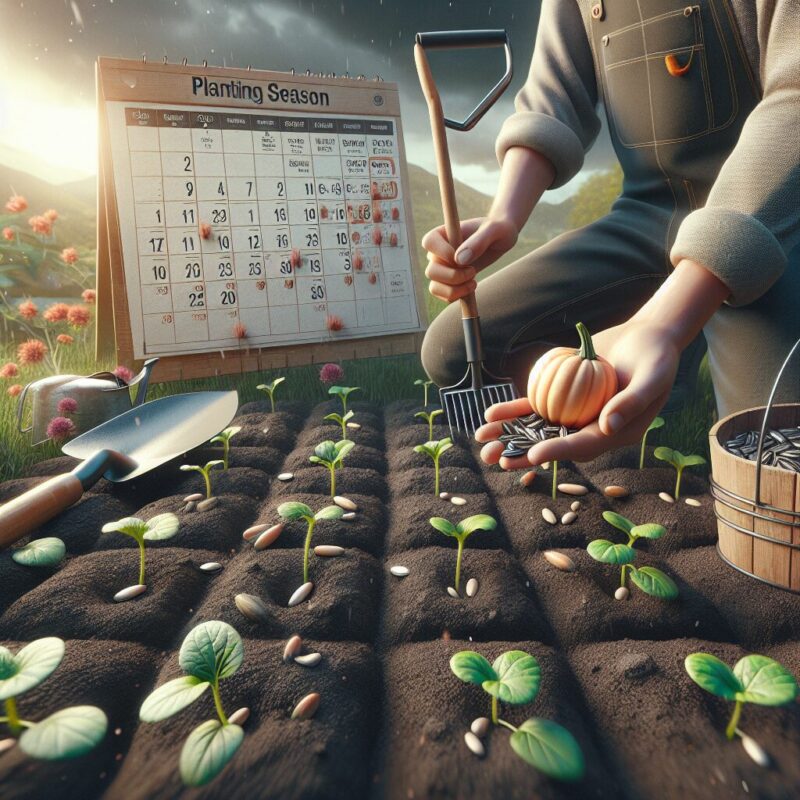When it comes to the topic of when to plant kabocha squash, there are a few important factors to consider. Kabocha squash, also known as Japanese pumpkin, is a popular winter squash known for its sweet, nutty flavor and creamy texture. One unique fact about kabocha squash is that it is rich in nutrients such as vitamin A, vitamin C, and fiber, making it a healthy addition to any diet. Furthermore, this vegetable is known for its versatility in cooking, as it can be roasted, steamed, or used in soups and stews.
Now, let’s move on to the key takeaways regarding when to plant kabocha squash. Timing is crucial when it comes to growing this vegetable, as it requires warm soil and frost-free conditions to thrive. Generally, kabocha squash is planted in late spring to early summer, once the soil has warmed up and the threat of frost has passed. Additionally, it is essential to choose a sunny location with well-draining soil for optimal growth. In the following sections, we will delve deeper into the specific steps to take when planting kabocha squash, including preparing the soil, selecting the right variety, and caring for the plants throughout the growing season. Stay tuned for valuable tips and insights on successfully cultivating this delicious and nutritious vegetable.
Key Takeaways
1. Kabocha squash should be planted after the threat of frost has passed and the soil has warmed up, which is typically in late spring or early summer.
2. It is important to choose a sunny location with well-drained soil for planting kabocha squash, as they require at least 6 to 8 hours of direct sunlight daily for optimal growth.
3. The soil for kabocha squash should be rich in organic matter and have a pH level between 6 and 6.8. Adding compost or aged manure can help improve the soil quality.
4. When planting kabocha squash, it is recommended to space the plants about 4 to 6 feet apart, allowing enough room for the vines to spread.
5. Regular watering is crucial for the development of kabocha squash, ensuring that the soil is consistently moist but not waterlogged. Mulching can help retain moisture and suppress weed growth around the plants.
When is the Best Time to Plant Kabocha Squash?
Choosing the Right Season
Kabocha squash, also known as Japanese pumpkin, thrives in warm weather conditions. It is crucial to plant when the risk of frost has passed and the soil temperature has warmed up.
Seasonal Considerations
In most regions, Kabocha squash is typically planted in the spring or early summer. However, the exact timing may vary depending on your specific location and climate. It is important to take into account the length of your growing season.
Spring Planting
If you live in a region with mild winters and a longer growing season, planting Kabocha squash in spring is ideal. Wait until the soil has warmed up to at least 60°F (15°C) before sowing the seeds or transplanting seedlings.
Early Summer Planting
In areas with shorter growing seasons, it may be better to wait until early summer to plant Kabocha squash. By this time, the risk of frost should have passed, and the soil should be sufficiently warm for optimal germination and growth.
Soil Temperature Requirements
Kabocha squash prefers a soil temperature between 70°F and 95°F (21°C and 35°C). Planting too early when the soil is still cold can lead to poor seed germination and stunted growth. Using a soil thermometer can help you determine if the conditions are right for planting.
Preparing the Soil
Before planting Kabocha squash, it is essential to prepare the soil properly. This includes removing any weeds or grass, breaking up compacted soil, and incorporating organic matter such as compost or aged manure.
Planting Techniques
Once the soil is ready, there are two primary methods for planting Kabocha squash: direct seeding and transplanting. Direct seeding involves sowing the seeds directly into the garden bed, while transplanting entails starting the seeds indoors and then moving the seedlings into the garden.
Direct Seeding
Direct seeding is preferable when the soil temperature has warmed up and there is no longer a risk of frost. Sow the seeds about 1 inch (2.5 cm) deep and 2-3 feet (60-90 cm) apart, with rows spaced about 6-8 feet (1.8-2.4 m) apart. This allows adequate room for the vigorous vine growth.
Transplanting Seedlings
If you choose to start Kabocha squash seeds indoors, begin the process about 2-4 weeks before the last expected frost date. Use biodegradable pots or trays to prevent root disturbance during transplantation. Transplant the seedlings when they have 2-3 true leaves, ensuring they are properly hardened off before planting them outdoors.
Caring for Kabocha Squash Plants
Once you’ve planted your Kabocha squash, there are several essential care practices to follow:
Watering
Provide regular watering to keep the soil consistently moist but not waterlogged. Aim for about 1-1.5 inches (2.5-3.8 cm) of water per week, adjusting during hot and dry periods.
Fertilizing
Apply a balanced fertilizer or organic compost to provide nutrients for the growing plants. Follow the package instructions or consult a gardening expert for specific recommendations.
Support and Space
Kabocha squash plants are vigorous climbers, so providing support such as trellises or sturdy cages will prevent sprawling and save space in your garden.
Pest and Disease Management
Regularly monitor your plants for common pests like squash bugs or powdery mildew. Implement preventive measures such as using row covers, practicing crop rotation, and applying organic insecticides or fungicides, if necessary.
Conclusion
Successful Kabocha squash cultivation begins with planting at the right time. By considering the seasonal factors, soil temperature requirements, and proper planting techniques, you can ensure healthy growth and a bountiful harvest of this delicious winter squash variety.
Now that you’re ready to plant Kabocha squash, here are some essential tips:
- Provide the plants with plenty of sun exposure, at least 6-8 hours a day.
- Protect young seedlings from cold or frost by using row covers or cloches.
- Be mindful of pests and take prompt action if you notice any signs of infestation.
- Harvest the Kabocha squash when the skin has hardened, and the stem looks dry and brown.
- Store the harvested squash in a cool, dry place for several weeks to enhance its flavor and sweetness.
When To Plant Kabocha Squash – FAQ
1. Can I plant Kabocha Squash in any season?
While Kabocha Squash can be grown in various seasons, it is best to plant them during the spring or early summer when the soil temperature reaches around 60°F (15°C). This will ensure optimal growth and yield.
2. Do I need to start the seeds indoors?
Yes, it is recommended to start Kabocha Squash seeds indoors a few weeks before the last frost date in your region. This will give the seeds a head start and allow for a longer growing season.
3. How deep should I plant the Kabocha Squash seeds?
Plant the Kabocha Squash seeds about an inch deep in well-drained soil. Ensure that the soil is loose and not compacted to promote proper root development.
4. How much space should I leave between Kabocha Squash plants?
Provide each Kabocha Squash plant with a spacing of about 3 to 4 feet apart. This allows for adequate air circulation and room for the plants to grow and spread their vines.
5. Can I use mulch around the Kabocha Squash plants?
Using mulch around the Kabocha Squash plants can be beneficial as it helps to retain moisture, suppress weed growth, and maintain more even soil temperatures. Apply a layer of organic mulch, such as straw or wood chips, around the base of the plants.
6. How often should I water Kabocha Squash?
Keep the soil consistently moist but not waterlogged. Water deeply once or twice a week, allowing the top inch of soil to dry out between waterings. Adjust the frequency based on weather conditions and soil moisture levels.
7. Can Kabocha Squash tolerate frost?
Kabocha Squash is not frost-tolerant and will be damaged by freezing temperatures. It is important to protect the plants from frost by covering them with a row cover, cloths, or other protective materials when frost is expected.
8. When can I expect to harvest Kabocha Squash?
Kabocha Squash typically takes around 80 to 100 days to reach maturity after planting. You can start harvesting Kabocha Squash when the skin turns a deep, rich color and the stem begins to dry and wither. Use a sharp knife or pruning shears to cut the squash from the vine, leaving a short stem attached.
9. How should I store harvested Kabocha Squash?
Harvested Kabocha Squash should be cured and stored in a cool, dry, and well-ventilated area. Keep them off the ground on racks or shelves, ensuring they don’t touch each other. Properly stored Kabocha Squash can last for several months.
10. Can I save seeds from Kabocha Squash for future planting?
Yes, you can save seeds from Kabocha Squash for future planting. Simply remove the seeds from the ripe squash, rinse off any pulp, and allow them to dry completely. Store the dried seeds in a cool, dark, and dry place in an airtight container until ready to be planted.
Final Thoughts
When it comes to planting Kabocha Squash, timing is crucial for a successful harvest. By planting the seeds in the right season and providing proper care, you can enjoy a bountiful crop of this nutritious and delicious squash.
Remember to start the seeds indoors before the last frost date, provide adequate spacing, and protect the plants from frost. Regular watering, mulching, and proper storage are also important factors to consider. With patience and diligence, you can savor the flavors of fresh, homegrown Kabocha Squash from your own garden.

